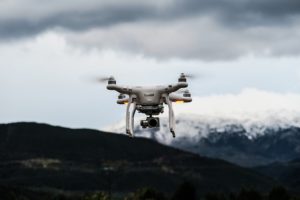

By DRONELIFE Staff Writer Jim Magill
First responders and law enforcement agencies are increasingly relying on drone-captured live-streamed video to increase their ability to observe a rapidly unfolding situation, whether it’s from the scene of a large-scale disaster, or the venue of a giant, internationally viewed sporting event.
Dejero, a Canadian technology company that specializes in providing resilient connectivity for critical communications, recently provided its video transmission equipment to the San Diego Police Department to enhance its situational awareness at the site of the 121st US Open golf tournament at the Torrey Pines South Course.
Less than a week later, the company provided a video platform through one of its drone company partners, to distribute real-time video data to first responders taking part in rescue operations in Surfside Florida, following the partial collapse of a condo tower building.
“Drones are becoming the second largest contributor of video information outside of body cameras. They’re adding a lot of video to the public safety environments in law enforcement and fire as well,” said Jehan Karim, business development manager at Dejero.
Karim said the 13-year-old privately owned Waterloo, Ontario-based company was founded as a video provider for the broadcast news industry. Then, about three years ago, the company began expanding its video platform service into the public safety and national defense markets. Since entering those markets, the business has grown rapidly, expanding by about eightfold.
“We’re on a strong trajectory, in the initial phases of growing business. We’ve identified our core strengths and our core partners,” he said.
Drone-Captured Live-Stream and First Responders
First responders — including emergency medical services, and fire and law enforcement agencies –demand high-quality streaming video services for surveillance and situational awareness and to help ensure the safety and security of their operations.
“We come from a practice of delivering video; it doesn’t matter if it’s coming from New York, London, Hong Kong, Afghanistan or Syria. It has to get there,” Karim said. The same expertise was critical in the company’s response to the situations in San Diego and Surfside, he said.
“In both situations, the need for reliability, the critical nature of the video and the tactical environment in which the network had to operate were very similar.”
In the case of the U.S. Open, Dejero provided its EnGo 260 mobile transmitter and GateWay 211 network aggregation device to San Diego P.D., enabling police officers and incident commanders to monitor live video and access mission-critical apps both from the joint operations center command post and police headquarters.
The technology allowed the police to eliminate the problem of network congestion common with high-profile sports event like the Open. By combining all available cellular networks into a single service during the event, Dejero was able to provide uninterrupted internet connectivity that enabled the police to monitor every aspect of activity taking place at the golf course in real-time.
Partnering with local network engineering experts AggreGateway, the Dejero connected its mobile transmitter to a drone base station and the transmitter fed the real-time video data back to the San Diego PD’s command post and headquarters over cellular.
Providing Drone Live Stream in Challenging Conditions
At the site of the tower collapse in Surfside, Dejero partnered with VolAero Drones, which flew a tethered drone over the disaster site, to provide a live video feed to the emergency operations centers of the multiple responding agencies. As in the case of the U.S. Open, the network environment was complicated, crowded with competing electronic signals from newscasters first responders and onlookers using the cell phones.
“It was very contested, congested, and even damaged networking environment and we were providing services there,” Karim said.
The demand from first-responder agencies for drone-collected video is exploding, as agencies see the usefulness of collecting images from a scene quickly and efficiently, without putting their personnel in unnecessary danger, he said.
“We see that the drones fit into the public safety environment very strategically. Not only is it improving the first response, it’s optimizing how information is being collected — less costly, more efficiently from a time perspective,” Karim said.
In addition to having the capability of transmitting live video, drones can be equipped with sensors to collect a variety types of data from a site — such as temperature, wind conditions and GPS coordinates – of great use to first responders.
For example, using drones supported by the Dejero video technology, firefighters arriving on the scene of a fire can quickly assess the extent and intensity of the fire and determine the best way to attack it. “When they’re responding to a fire the firefighters on the engine have just three or four minutes to collect every piece of information they can get. After that point, they’re going to be in the fire,” Karim said.
The technology also allows for the widespread dissemination of the video and data, another key to launching a coordinated response to a situation.
“Instead of the drone just sending the video to the pilot, now the drone can send video to anyone who needs to have access to that video. In under two seconds, anyone who’s got access to a web browser, whether it’s on phone, a laptop or a big screen at an operations center, as long as they can access an HTML web browser, they can get access to the live-stream video,” he said